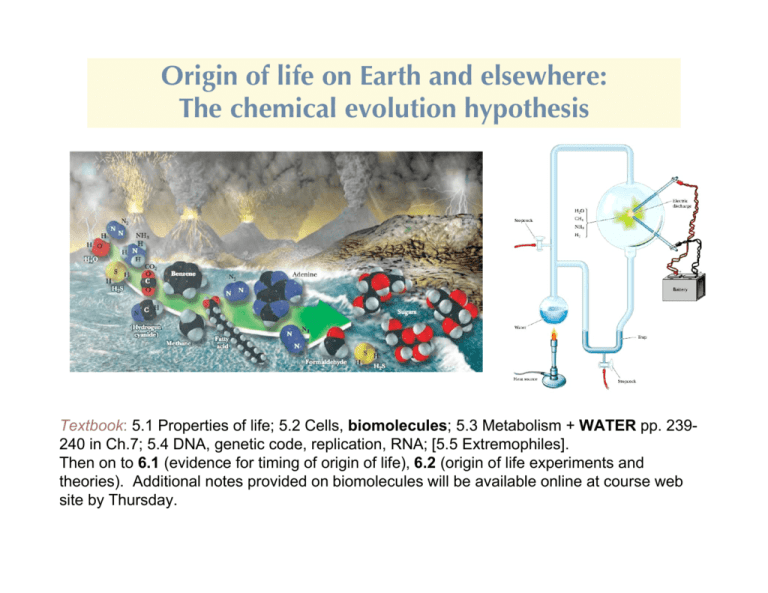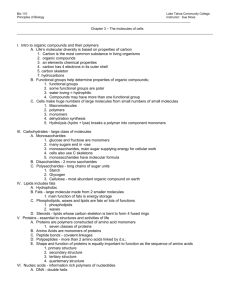Origin of life on Earth and elsewhere: The chemical evolution
advertisement

Origin of life on Earth and elsewhere: The chemical evolution hypothesis Textbook: 5.1 Properties of life; 5.2 Cells, biomolecules; 5.3 Metabolism + WATER pp. 239240 in Ch.7; 5.4 DNA, genetic code, replication, RNA; [5.5 Extremophiles]. Then on to 6.1 (evidence for timing of origin of life), 6.2 (origin of life experiments and theories). Additional notes provided on biomolecules will be available online at course web site by Thursday. The necessary elemental ingredients were available • Living matter consists of a relatively small number of elements. Four elements account for >97% of the atoms in living things: hydrogen (H), oxygen (O), carbon (C), nitrogen (N) ~60% ~25% ~10% ~2% +phosphorus, sulfur, and calcium (about 0.1% each) +trace elements (e.g. iron, zinc, magnesium, manganese, . . .) <0.01% • Sun + Stars ---remarkable uniformity (abundances derived from analyses of spectral lines). Result: H, C, N, O most abundant elements in stars, galaxies, the distant universe, as well as in life. → Suggests that our type of life, HCNO (+important trace elements), is the most likely type in the universe, based on availability. Maybe even the simplest molecules of life are easy to come by Support for this conclusion: • Discovery of amino acids and other biologically-related molecules in meteorites (350, compared to 46 on earth)*; sugar discovered in 2001. See Table below. You will soon become familiar with the types of molecules listed! *1994:Biologist Carlisle claims at least 2 of them are dandruff • Discovery of fairly complex organic molecules in interstellar space (discussed in Part I of the course). However none of the biomolecules listed in the table below have Been found in the interstellar medium We do understand why carbon is the only molecule on which to base a complex chemistry Carbon's importance stems from its bonding capacity. With 4 outer shell electrons, it needs to link with 4 more to achieve stability (“tetravalent”), but can also form molecules with a smaller number of bonds. M ajor advantages: 1. C forms stable molecules – strong covalent bond s C-C 83 kcal/mol C=C 146 (1 mole - 6!1023 bonds C-N 70 C" C 212 1 cal = 4.184 Joule) C-O 84 C - H 99 So specific enzymes capable of releasing a large amount of energy are needed to break these bonds. A lso, visible light is unable to break covalent bonds, but UV can # hazard because of cell damage; but also the source of mutations (and therefore evolution). 2. C-containing molecules are diverse. Can bond with other C atoms to make long chains (e.g. in lipids) and rings (e.g. benzene, or, with other atoms, the bases that are used to make nucleic acids). Further variety is possible by side-branching (often using certain characteristic “functional groups”) or double or triple (e.g. CH"CH, acetylene) bonds. See pictures of membrane lipids, amino acid structure, and nucleic acids. W hen H atoms are used to complete valence requirements of such molecules, the compounds are called hydrocarbons (e.g. octane, an 8-carbon compound C8H18). These are insoluble in water, but that is why they are so important (tails of phospholipid membrane molecules, something we already mentioned in connection with hydrophobic molecules). The versatility of carbon Hydrocarbons: Several ways to add H: Five carbon skeletons Five member hydrocarbons single bond double bond More complex organics built using the simpler molecules Environmental setting for the origin of life: Probably had to wait until after the Hadean era: Heavy bombardment, molten Earth pummeled by gigantic planetesimals, intense ultraviolet radiation. For origin of life we only care about time periods indicated below (The evidence for life arising about 3-4 Gyr ago is discussed in Ch.6) How could life arise in such a tumultuous environment? Prokaryotic cells are certainly the most ancient of organisms, but how ancient? The Earliest Trace of Life? This fossil from Western Australia is 3.5 billion years old and shows carbon traces that indicate life. Its form is similar to that of modern filamentous cyanobacteria (inset). From 2008 edition of well-known intro.biology textbook Science 8 March 2002 : “Earliest Signs of Life Just Oddly Shaped Crud?” All life today is cellular, but there are two semi-distinct types: Prokaryotes, comprising the various types of bacteria, have relatively simple structures and are almost all unicellular (although they may form filaments or colonies). Eukaryotes are multicellular as well as unicellular, and are vastly more complex than prokaryotes. (Viruses are much simpler entities than cells and are not classified as living because they lack the metabolic apparatus to reproduce outside their host cells. Similarly, prions are proteins-gone-bad that can transform the working proteins into more prions, but aren’t considered living.) Some prokaryotic organisms Eukaryotic cells Eukaryotic cells have a thousand to a million times the volume of prokaryotes. The main difference is a profusion of membrane-enclosed organelles, i.e. they are highly modular. In addition to a nucleus, eukaryotes have an endoplasmic reticulum, the site of synthesis of many cellular components, some subsequently modified in the Golgi apparatus. Aerobic metabolism takes place in mitochondria in almost all eukaryotes, and photosynthetic cells contain chloroplasts. Vacuoles, which are more prominent in plant cells, usually function as storage depots. The cytosol (the cytoplasm minus its membrane-bounded organelles) is organized by the cytoskeleton, an extensive array of filaments that also gives the cell its shape and the ability to move. Eukaryotes are so obviously products of extensive adaptation and symbiosis that they are only good examples of what we should ignore, until we discuss the possiblity of complex life. Prokaryotes are already far too complex to be relevant to origin of life. Usual broad view of the origin of life on Earth: We are only concerned with the “origin” part indicated by boxes Era of macromolecular development Huge leap!! Pictorial representation of the general idea of chemical evolution hypothesis “Exogenous” asteroids, comets “Endogenous” Miller-Urey-type experiments Properties of Life on Earth (textbook sec. 5.1) These are only necessary, not sufficient, for the living state. “Order” What kind of order? Modular, hierarchical structure Energy utilization Crucial (but only necessary, not sufficient, e.g. electrical appliance, solar-powered car) Second law of thermodynamics: disorder would increase without some external energy source: The environment. Sunlight, geothermal heat, radioactivity, lightning, … eventually energy from food and chemical interactions. Combining these: Life locally reverses entropy increase by utilizing external source(s) of energy. Lots of nonliving systems do this. Almost none of them produce this kind of ordered structure. This focus on attributes of life runs danger of overlooking a key distinction: The potential to construct such a hierarchical structure. Book also lists: Reproduction: “difficult to survive death of individuals without it.” Can you think of a counter to this? It is a basic feature of all life today, and all life most people try to Imagine, but there are many models in which replication comes later, after (say) metabolism, or encapsulation (membranes). Viruses: rely on pre-existing life, some use RNA for reproduction. Few think of viruses as candidates for first living organisms. (Victor Koonin) Prions: abnormal forms of proteins that cause other proteins to assume their form. Also not discussed further. Artificial (computer) life: difficult case since it is implicitly programmed to obey rules known to give certain kinds of behavior. Growth and development. In living organisms on Earth this is directed by inherited traits. Response to environment. To distinguish from a thermostat, could say functional response. But how to relate this to origins? A suggestion: molecular recognition as the proto-response. Evolutionary adaptation. “Evolutionary” = “life has changed with time.” “Adaptation” = one of several modes by which organisms are believed to evolve; Natural selection is another name for it, but may not be dominant mode (in Japan, and a few groups in U.S.). This ends up being A clue: The hierarchical molecular structure of modern organisms may reflect the the development of life in time. Basic idea: The current structure of life is an accumulation of its origin and development What are we made of? Not simply polymers: Life as complexity arising from hierarchical/modular aggregation Currently: Life as an autocatalytic process Polynucleotides (nucleotide polymers) and proteins (amino acid polymers, polypeptides) provide the sequence information and the catalytic functions that serve—through a complex set of chemical reactions—to bring about the synthesis of more polynucleotides and proteins of the same types. This is probably irrelevant: The DNA/protein system is almost certainly a late product of evolution. How is it organized? Monomers (building blocks, left) polymerized into four types of polymers (right) Transition from nonliving to living: Chemical evolution hypothesis Assumes life arose as a sequence of increasingly complex chemical reactions, driven by the variety of energy sources present in the early Earth environment. The basic atoms used by life became more and more complex molecules --“monomers” like sugars, amino acids, nucleic acids, finally made the (difficult) transition to functioning biological molecules -“biopolymers” like lipids, proteins, RNA, DNA or their equivalents. Too complex to be relevant for origin of life Chemical evolution: The primary problem Theory for origin of life by chemical evolution must explain following: nuclei atoms molecules monomers polymers It's the last step that is the problem, as we’ll see. But biological polymers are clearly special, with potential for multiple stages of hierarchical structure. How is this possible? Carbon-based molecules can bend, twist, and fold, reversibly. Consider protein shown below. “Polypeptide” on far left is already a polymer (amino acids are the monomer).








